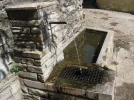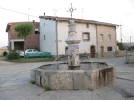- Time of past OR future Camino
- See signature.
So day 1 I head out of Irun beginning my trek on the Norte. I started up a hill, it was taxing. Anyways, after about 4-5k I find myself at a pleasant church with a miraculous view, and I sit down at a bench for a deserved rest.
I pull out my water bottle and proceed to drink away. I also pulled out an orange and ate it.
After the orange was eaten, and 3/4 of my water was consumed, I walked to the fountain along the path in front of the church.
That’s when I saw an official looking sign that said, “…no es para consumir…” Yikes!
So I walk back to my spot on the bench and it’s obvious I’ve been watched. The Peregrino on the next bench over points to the fountain. I couldn’t understand exactly what he was saying.
Then, what I would describe as a “local” bike rider also pointed to the fountain. He said he drinks the water every day and it’s fine.
I was reticent. They could tell. The bike rider was kind though, and he insisted the water was good, “pero no tratrada”… he drinks it everyday!
So I listened politely and then left along the way.
I won’t drink from a fountain that says “no consumir” no matter what the locals say.
Is this the right or wrong decision?
I pull out my water bottle and proceed to drink away. I also pulled out an orange and ate it.
After the orange was eaten, and 3/4 of my water was consumed, I walked to the fountain along the path in front of the church.
That’s when I saw an official looking sign that said, “…no es para consumir…” Yikes!
So I walk back to my spot on the bench and it’s obvious I’ve been watched. The Peregrino on the next bench over points to the fountain. I couldn’t understand exactly what he was saying.
Then, what I would describe as a “local” bike rider also pointed to the fountain. He said he drinks the water every day and it’s fine.
I was reticent. They could tell. The bike rider was kind though, and he insisted the water was good, “pero no tratrada”… he drinks it everyday!
So I listened politely and then left along the way.
I won’t drink from a fountain that says “no consumir” no matter what the locals say.
Is this the right or wrong decision?




















